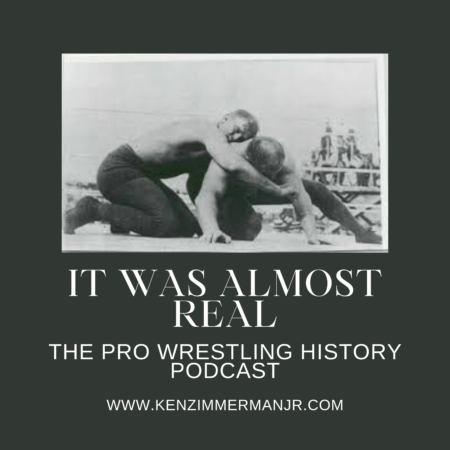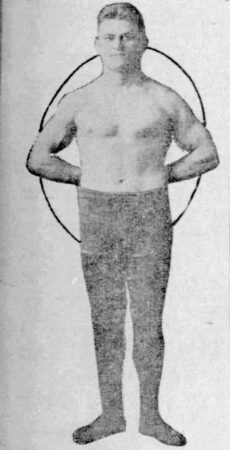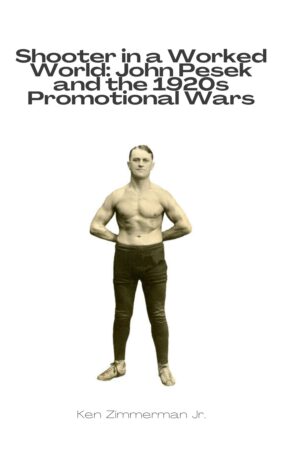Rov 50 – Wrestling thiab WWI
Podcast: Ua si nyob rau hauv cov qhov rai tshiab | Download tau
Hauv no rov, Peb tham txog li cas tsov rog ntiaj teb ua tsov ua rog kuv cuam tshuam American kev wrestling. Peb kuj qhia leej twg hais, “Repetition yog qhov tseem ceeb thaum soj ntsuam nrog goofs.”
Hloov tshiab
I am writing two books at once for the first time. Thawj phau ntawv yog kuv lub xeem los St. Louis keeb kwm phau ntawv rau St. Louis Chief ntawm Detectives William Desmond. The second book is a research project on John “Tus Nebraska Tsovman” Pesek, who settled several promotional wars by wrestling legitimate contests in the 1920s.

Podcast Art for the It Was Almost Real: Tus Pro Wrestling keeb kwm Podcast
Cov ntsiab lus tseem ceeb
Ntawm 1918 thiab 1919, the wrestling trust led by Jack Curley put John “Tus Nebraska Tsovman” Pesek in the same boat as Marin Plestina. Curley would not book Pesek against the “Plaub tug loj plaub” – World Champion Earl Caddock, former World Champion Joe Stecher, Ed “Strangler” Lewis, thiab Wladek Zbyszko. These four wrestlers contested for the World Title between 1915 thiab 1920.

John Pesek at 21 hnub nyoog rau xyoo 1915 (Public sau)
Curley was reluctant to book the wrestlers against Pesek because Pesek proved to be an effective shooter and hooker. Clarence Ecklund, a well-respected middleweight wrestler, trained Pesek in the carnival style of catch-as-catch-can wrestling. This style of wrestling focused on “nqe lauj” which are chokes and joint locks.
Since Pesek did not like to work with opponents, Curley worried that Pesek would shoot on on one of the “Plaub tug loj plaub” and try to defeat them legitimately. Pesek lack of interest in working with the big names kept him out of a deserved title shot.
Nyob rau hauv 1918, circumstances intervened to convince Curley to book a contest between Wladek Zbyszko and John Pesek in Omaha, Nebraska. World War I helped Pesek force Curley’s hand.
When America entered World War I in 1917, the government drafted professional wrestlers into the U.S. military. Caddock joined the Army and served in France during 1918 thiab 1919.
The government drafted Joe Stecher into the Navy. The government also drafted Pesek and his manager, Martin Slattery, into the Army. Txawm li cas los, the military stationed Stecher and Pesek stateside allowing them to wrestle the occasional match.
Even with Stecher and Pesek taking matches occasionally, promoters struggled to find wrestlers to fill out their card. Wladek Zbyszko, who was a Polish immigrant, was not drafted but Curley could not find many name opponents for him. Desperate for cash, Curley agreed to bring Zbyszko to Omaha to wrestle Pesek.
The gamble paid off financially as 5,000 fans attending the Stockmen’s Association Annual Meeting in Gibbon, Nebraska attended the match. The heat of the outdoor match sapped Zbyszko worse than Pesek, who won the only fall after two hours of hard wrestling.
While Pesek’s defeat of Zbyszko did not automatically result in Curley booking Pesek more, the impression Pesek met on Curley led to Curley choosing Pesek to represent Curley against Marin Plestina in the 1921 promotional war. The trip to Omaha proved profitable in more ways than one for Jack Curley.
rov xyuas dua
We take a look at the 1933 match in Athens, Greece between Jim Londos and Kola Kwariani. The match drew a crowd of 70,000 mus 100,000 spectators.
Koj yuav tawm ib saib los nug cov lus nug txog qhov no los yog tej tsev xa rau kuv Facebook phab.
PIN rau nws

